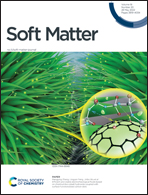Efficient and stable electrorheological fluids based on chestnut-like cobalt hydroxide coupled with surface-functionalized carbon dots†
Abstract
Intrinsically polarized electrorheological fluids (ERFs) have better thermal stability than ERFs with polar molecules, so they have a broader application prospect. However, the electrorheological efficiency of the common intrinsically polarized ERF is still lower than 1500, which is related to the poor wettability between polarized materials and the continuous phase. Carbon dots (CDs) exhibit good stability, semiconductor properties and low toxicity. We prepared biomimetic chestnut-like cobalt hydroxide coupled with surface-functionalized CD particles (Co(OH)2@CDs) by a simple hydrothermal method. Then we prepared an ERF by mixing Co(OH)2@CDs with silicone oil and studied the effect of CDs on its rheology and electrorheology properties. The synergistic effect of the lipophilic groups on the surface of CDs and the biomimetic chestnut-like structure makes Co(OH)2@CDs exhibit good wettability with silicone oil, and the optimal zero-field viscosity of Co(OH)2@CDs-ERF is only 0.46 Pa s (particle mass fraction of 40%). Exceptional electrorheological efficiency (about 10 000, shear rate 0.1 s−1, 5 kV mm−1) and dynamic shear stress stability of optimal Co(OH)2@CDs-ERF can be attributed to the dielectric enhancement of the biomimetic chestnut-like structure coupled with the semiconductor properties of CDs. In addition, Co(OH)2@CDs-ERF has excellent anti-settling performance, outstanding thermal stability and low current density.



 Please wait while we load your content...
Please wait while we load your content...